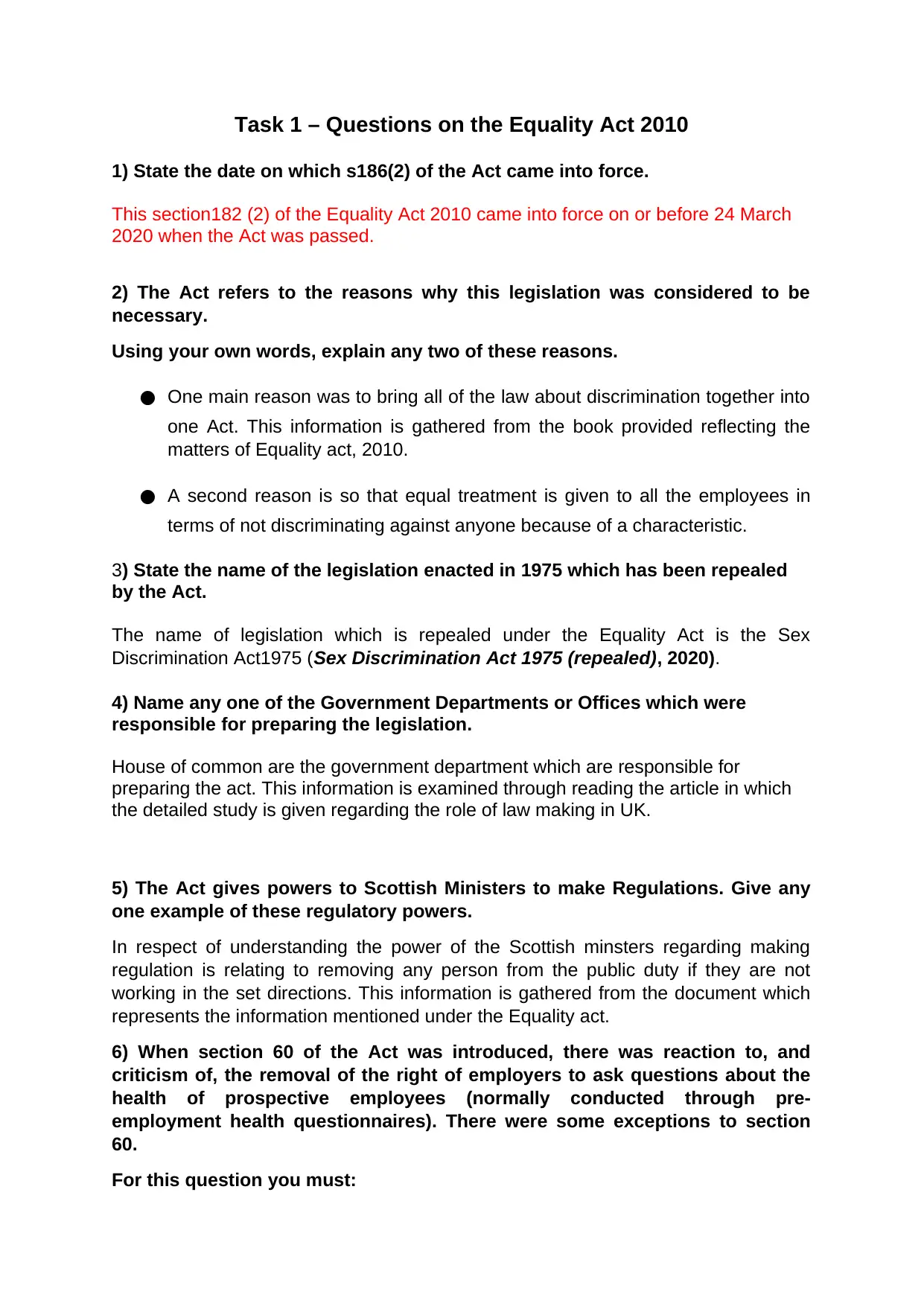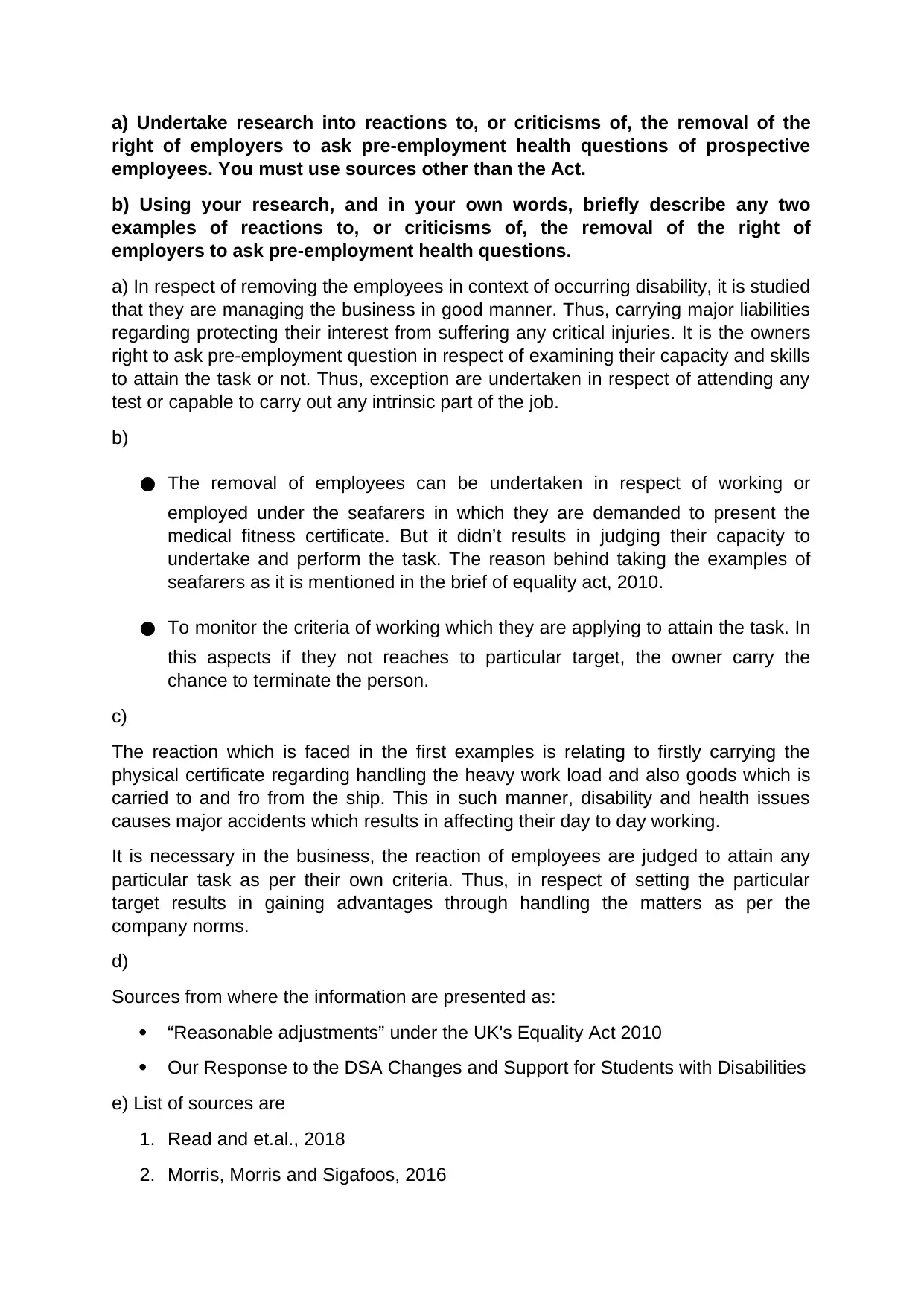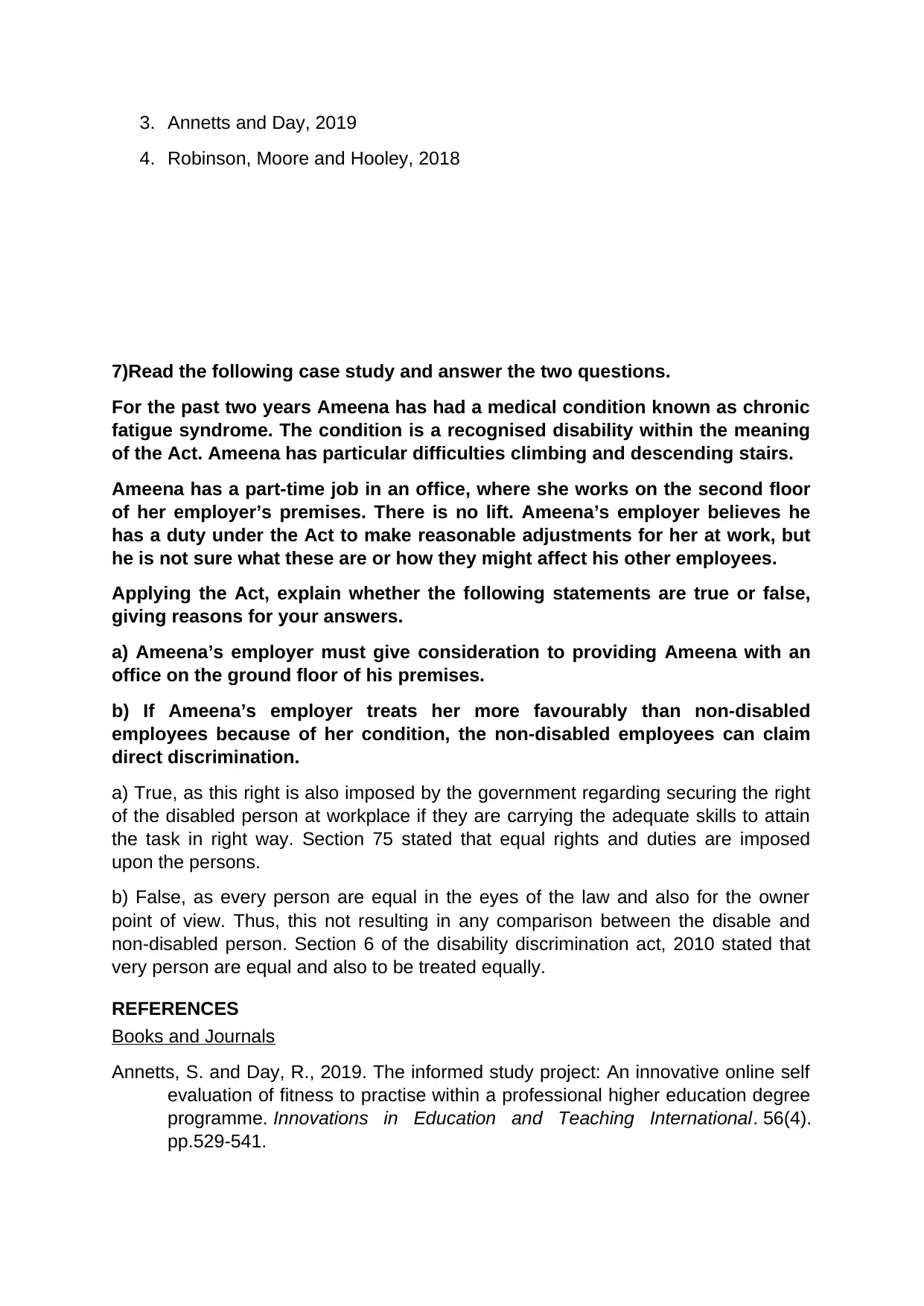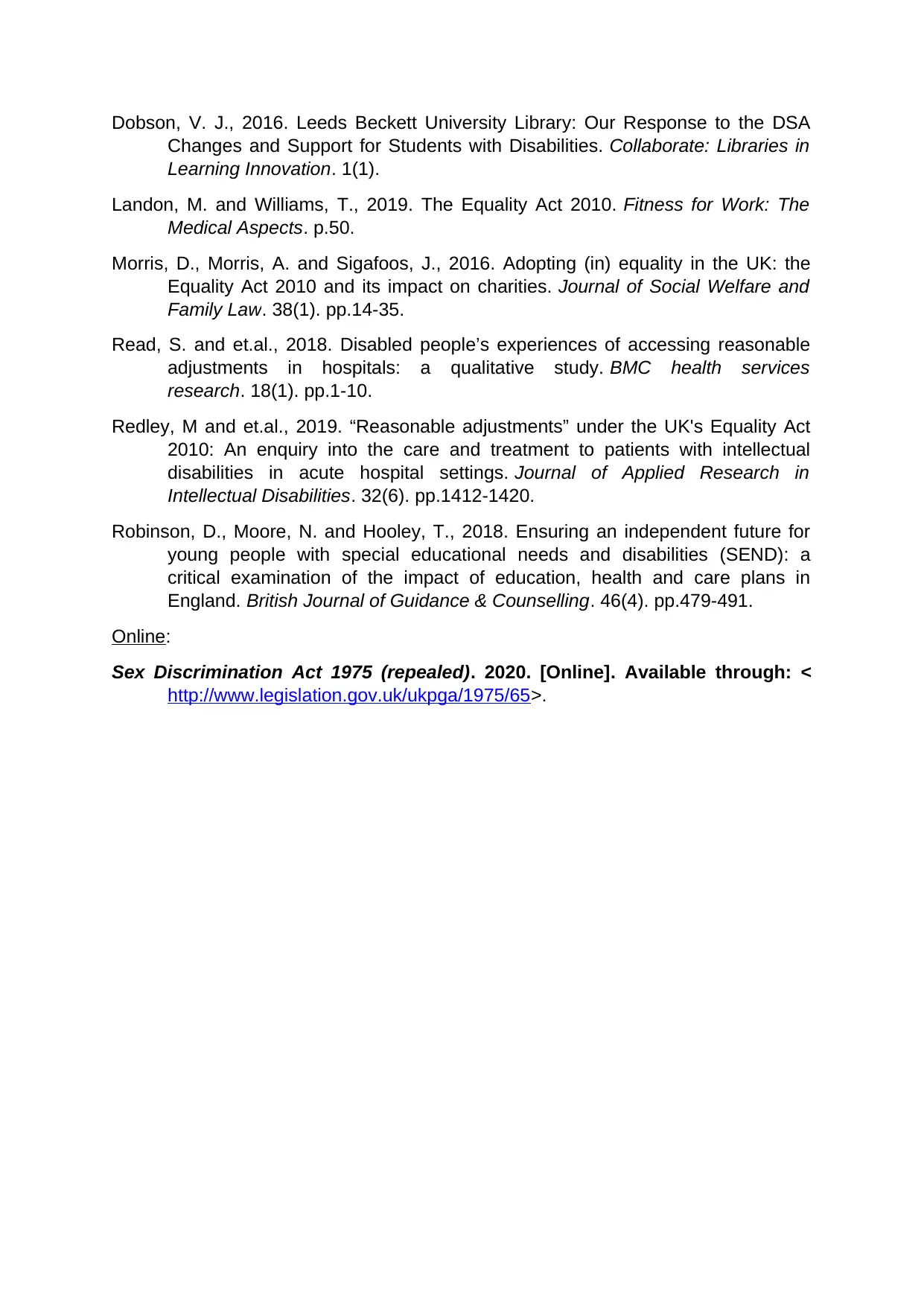Equality Act 2010: Analysis of Key Provisions and Case Studies
VerifiedAdded on 2023/01/12
|4
|1465
|62
Homework Assignment
AI Summary
This document provides a detailed analysis of the Equality Act 2010, addressing key questions and case studies related to the legislation. The assignment begins by identifying the commencement date of a specific section and explores the reasons behind the Act's necessity. It then delves into the repeal of previous legislation, the government departments involved, and the regulatory powers granted to Scottish Ministers. The assignment includes research on the reactions to the removal of employers' rights to ask pre-employment health questions, presenting criticisms and exceptions. Furthermore, a case study involving an employee with chronic fatigue syndrome is examined, applying the Act to determine whether certain statements regarding reasonable adjustments and discrimination are true or false. The document also provides references to books, journals, and online resources used in the analysis.

Task 1 – Questions on the Equality Act 2010
1) State the date on which s186(2) of the Act came into force.
This section182 (2) of the Equality Act 2010 came into force on or before 24 March
2020 when the Act was passed.
2) The Act refers to the reasons why this legislation was considered to be
necessary.
Using your own words, explain any two of these reasons.
● One main reason was to bring all of the law about discrimination together into
one Act. This information is gathered from the book provided reflecting the
matters of Equality act, 2010.
● A second reason is so that equal treatment is given to all the employees in
terms of not discriminating against anyone because of a characteristic.
3) State the name of the legislation enacted in 1975 which has been repealed
by the Act.
The name of legislation which is repealed under the Equality Act is the Sex
Discrimination Act1975 (Sex Discrimination Act 1975 (repealed), 2020).
4) Name any one of the Government Departments or Offices which were
responsible for preparing the legislation.
House of common are the government department which are responsible for
preparing the act. This information is examined through reading the article in which
the detailed study is given regarding the role of law making in UK.
5) The Act gives powers to Scottish Ministers to make Regulations. Give any
one example of these regulatory powers.
In respect of understanding the power of the Scottish minsters regarding making
regulation is relating to removing any person from the public duty if they are not
working in the set directions. This information is gathered from the document which
represents the information mentioned under the Equality act.
6) When section 60 of the Act was introduced, there was reaction to, and
criticism of, the removal of the right of employers to ask questions about the
health of prospective employees (normally conducted through pre-
employment health questionnaires). There were some exceptions to section
60.
For this question you must:
1) State the date on which s186(2) of the Act came into force.
This section182 (2) of the Equality Act 2010 came into force on or before 24 March
2020 when the Act was passed.
2) The Act refers to the reasons why this legislation was considered to be
necessary.
Using your own words, explain any two of these reasons.
● One main reason was to bring all of the law about discrimination together into
one Act. This information is gathered from the book provided reflecting the
matters of Equality act, 2010.
● A second reason is so that equal treatment is given to all the employees in
terms of not discriminating against anyone because of a characteristic.
3) State the name of the legislation enacted in 1975 which has been repealed
by the Act.
The name of legislation which is repealed under the Equality Act is the Sex
Discrimination Act1975 (Sex Discrimination Act 1975 (repealed), 2020).
4) Name any one of the Government Departments or Offices which were
responsible for preparing the legislation.
House of common are the government department which are responsible for
preparing the act. This information is examined through reading the article in which
the detailed study is given regarding the role of law making in UK.
5) The Act gives powers to Scottish Ministers to make Regulations. Give any
one example of these regulatory powers.
In respect of understanding the power of the Scottish minsters regarding making
regulation is relating to removing any person from the public duty if they are not
working in the set directions. This information is gathered from the document which
represents the information mentioned under the Equality act.
6) When section 60 of the Act was introduced, there was reaction to, and
criticism of, the removal of the right of employers to ask questions about the
health of prospective employees (normally conducted through pre-
employment health questionnaires). There were some exceptions to section
60.
For this question you must:
Paraphrase This Document
Need a fresh take? Get an instant paraphrase of this document with our AI Paraphraser

a) Undertake research into reactions to, or criticisms of, the removal of the
right of employers to ask pre-employment health questions of prospective
employees. You must use sources other than the Act.
b) Using your research, and in your own words, briefly describe any two
examples of reactions to, or criticisms of, the removal of the right of
employers to ask pre-employment health questions.
a) In respect of removing the employees in context of occurring disability, it is studied
that they are managing the business in good manner. Thus, carrying major liabilities
regarding protecting their interest from suffering any critical injuries. It is the owners
right to ask pre-employment question in respect of examining their capacity and skills
to attain the task or not. Thus, exception are undertaken in respect of attending any
test or capable to carry out any intrinsic part of the job.
b)
● The removal of employees can be undertaken in respect of working or
employed under the seafarers in which they are demanded to present the
medical fitness certificate. But it didn’t results in judging their capacity to
undertake and perform the task. The reason behind taking the examples of
seafarers as it is mentioned in the brief of equality act, 2010.
● To monitor the criteria of working which they are applying to attain the task. In
this aspects if they not reaches to particular target, the owner carry the
chance to terminate the person.
c)
The reaction which is faced in the first examples is relating to firstly carrying the
physical certificate regarding handling the heavy work load and also goods which is
carried to and fro from the ship. This in such manner, disability and health issues
causes major accidents which results in affecting their day to day working.
It is necessary in the business, the reaction of employees are judged to attain any
particular task as per their own criteria. Thus, in respect of setting the particular
target results in gaining advantages through handling the matters as per the
company norms.
d)
Sources from where the information are presented as:
“Reasonable adjustments” under the UK's Equality Act 2010
Our Response to the DSA Changes and Support for Students with Disabilities
e) List of sources are
1. Read and et.al., 2018
2. Morris, Morris and Sigafoos, 2016
right of employers to ask pre-employment health questions of prospective
employees. You must use sources other than the Act.
b) Using your research, and in your own words, briefly describe any two
examples of reactions to, or criticisms of, the removal of the right of
employers to ask pre-employment health questions.
a) In respect of removing the employees in context of occurring disability, it is studied
that they are managing the business in good manner. Thus, carrying major liabilities
regarding protecting their interest from suffering any critical injuries. It is the owners
right to ask pre-employment question in respect of examining their capacity and skills
to attain the task or not. Thus, exception are undertaken in respect of attending any
test or capable to carry out any intrinsic part of the job.
b)
● The removal of employees can be undertaken in respect of working or
employed under the seafarers in which they are demanded to present the
medical fitness certificate. But it didn’t results in judging their capacity to
undertake and perform the task. The reason behind taking the examples of
seafarers as it is mentioned in the brief of equality act, 2010.
● To monitor the criteria of working which they are applying to attain the task. In
this aspects if they not reaches to particular target, the owner carry the
chance to terminate the person.
c)
The reaction which is faced in the first examples is relating to firstly carrying the
physical certificate regarding handling the heavy work load and also goods which is
carried to and fro from the ship. This in such manner, disability and health issues
causes major accidents which results in affecting their day to day working.
It is necessary in the business, the reaction of employees are judged to attain any
particular task as per their own criteria. Thus, in respect of setting the particular
target results in gaining advantages through handling the matters as per the
company norms.
d)
Sources from where the information are presented as:
“Reasonable adjustments” under the UK's Equality Act 2010
Our Response to the DSA Changes and Support for Students with Disabilities
e) List of sources are
1. Read and et.al., 2018
2. Morris, Morris and Sigafoos, 2016

3. Annetts and Day, 2019
4. Robinson, Moore and Hooley, 2018
7)Read the following case study and answer the two questions.
For the past two years Ameena has had a medical condition known as chronic
fatigue syndrome. The condition is a recognised disability within the meaning
of the Act. Ameena has particular difficulties climbing and descending stairs.
Ameena has a part-time job in an office, where she works on the second floor
of her employer’s premises. There is no lift. Ameena’s employer believes he
has a duty under the Act to make reasonable adjustments for her at work, but
he is not sure what these are or how they might affect his other employees.
Applying the Act, explain whether the following statements are true or false,
giving reasons for your answers.
a) Ameena’s employer must give consideration to providing Ameena with an
office on the ground floor of his premises.
b) If Ameena’s employer treats her more favourably than non-disabled
employees because of her condition, the non-disabled employees can claim
direct discrimination.
a) True, as this right is also imposed by the government regarding securing the right
of the disabled person at workplace if they are carrying the adequate skills to attain
the task in right way. Section 75 stated that equal rights and duties are imposed
upon the persons.
b) False, as every person are equal in the eyes of the law and also for the owner
point of view. Thus, this not resulting in any comparison between the disable and
non-disabled person. Section 6 of the disability discrimination act, 2010 stated that
very person are equal and also to be treated equally.
REFERENCES
Books and Journals
Annetts, S. and Day, R., 2019. The informed study project: An innovative online self
evaluation of fitness to practise within a professional higher education degree
programme. Innovations in Education and Teaching International. 56(4).
pp.529-541.
4. Robinson, Moore and Hooley, 2018
7)Read the following case study and answer the two questions.
For the past two years Ameena has had a medical condition known as chronic
fatigue syndrome. The condition is a recognised disability within the meaning
of the Act. Ameena has particular difficulties climbing and descending stairs.
Ameena has a part-time job in an office, where she works on the second floor
of her employer’s premises. There is no lift. Ameena’s employer believes he
has a duty under the Act to make reasonable adjustments for her at work, but
he is not sure what these are or how they might affect his other employees.
Applying the Act, explain whether the following statements are true or false,
giving reasons for your answers.
a) Ameena’s employer must give consideration to providing Ameena with an
office on the ground floor of his premises.
b) If Ameena’s employer treats her more favourably than non-disabled
employees because of her condition, the non-disabled employees can claim
direct discrimination.
a) True, as this right is also imposed by the government regarding securing the right
of the disabled person at workplace if they are carrying the adequate skills to attain
the task in right way. Section 75 stated that equal rights and duties are imposed
upon the persons.
b) False, as every person are equal in the eyes of the law and also for the owner
point of view. Thus, this not resulting in any comparison between the disable and
non-disabled person. Section 6 of the disability discrimination act, 2010 stated that
very person are equal and also to be treated equally.
REFERENCES
Books and Journals
Annetts, S. and Day, R., 2019. The informed study project: An innovative online self
evaluation of fitness to practise within a professional higher education degree
programme. Innovations in Education and Teaching International. 56(4).
pp.529-541.
⊘ This is a preview!⊘
Do you want full access?
Subscribe today to unlock all pages.

Trusted by 1+ million students worldwide

Dobson, V. J., 2016. Leeds Beckett University Library: Our Response to the DSA
Changes and Support for Students with Disabilities. Collaborate: Libraries in
Learning Innovation. 1(1).
Landon, M. and Williams, T., 2019. The Equality Act 2010. Fitness for Work: The
Medical Aspects. p.50.
Morris, D., Morris, A. and Sigafoos, J., 2016. Adopting (in) equality in the UK: the
Equality Act 2010 and its impact on charities. Journal of Social Welfare and
Family Law. 38(1). pp.14-35.
Read, S. and et.al., 2018. Disabled people’s experiences of accessing reasonable
adjustments in hospitals: a qualitative study. BMC health services
research. 18(1). pp.1-10.
Redley, M and et.al., 2019. “Reasonable adjustments” under the UK's Equality Act
2010: An enquiry into the care and treatment to patients with intellectual
disabilities in acute hospital settings. Journal of Applied Research in
Intellectual Disabilities. 32(6). pp.1412-1420.
Robinson, D., Moore, N. and Hooley, T., 2018. Ensuring an independent future for
young people with special educational needs and disabilities (SEND): a
critical examination of the impact of education, health and care plans in
England. British Journal of Guidance & Counselling. 46(4). pp.479-491.
Online:
Sex Discrimination Act 1975 (repealed). 2020. [Online]. Available through: <
http://www.legislation.gov.uk/ukpga/1975/65>.
Changes and Support for Students with Disabilities. Collaborate: Libraries in
Learning Innovation. 1(1).
Landon, M. and Williams, T., 2019. The Equality Act 2010. Fitness for Work: The
Medical Aspects. p.50.
Morris, D., Morris, A. and Sigafoos, J., 2016. Adopting (in) equality in the UK: the
Equality Act 2010 and its impact on charities. Journal of Social Welfare and
Family Law. 38(1). pp.14-35.
Read, S. and et.al., 2018. Disabled people’s experiences of accessing reasonable
adjustments in hospitals: a qualitative study. BMC health services
research. 18(1). pp.1-10.
Redley, M and et.al., 2019. “Reasonable adjustments” under the UK's Equality Act
2010: An enquiry into the care and treatment to patients with intellectual
disabilities in acute hospital settings. Journal of Applied Research in
Intellectual Disabilities. 32(6). pp.1412-1420.
Robinson, D., Moore, N. and Hooley, T., 2018. Ensuring an independent future for
young people with special educational needs and disabilities (SEND): a
critical examination of the impact of education, health and care plans in
England. British Journal of Guidance & Counselling. 46(4). pp.479-491.
Online:
Sex Discrimination Act 1975 (repealed). 2020. [Online]. Available through: <
http://www.legislation.gov.uk/ukpga/1975/65>.
1 out of 4
Related Documents
Your All-in-One AI-Powered Toolkit for Academic Success.
+13062052269
info@desklib.com
Available 24*7 on WhatsApp / Email
![[object Object]](/_next/static/media/star-bottom.7253800d.svg)
Unlock your academic potential
Copyright © 2020–2025 A2Z Services. All Rights Reserved. Developed and managed by ZUCOL.




